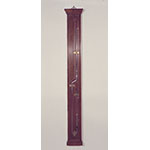This new type of siphon barometer was invented in 1816 by the French chemist Joseph-Louis Gay-Lussac. The present specimen dates from the first half of the nineteenth century. The barometric tube containing mercury is fixed to a wooden board with a frame. The lower arm of the tube is broken. The instrument was noteworthy for its precision and transportability, achieved thanks to the capillary tube connecting the two branches. It was used in meteorology and in chemistry laboratories.
Inventors
Context
Simulation
Dictionary
In depth










